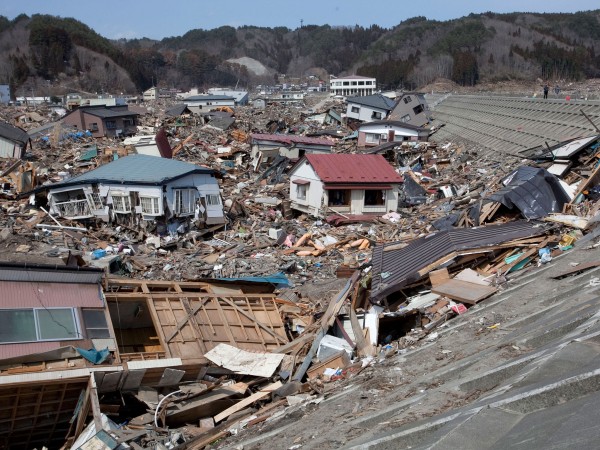
Most of the destruction that day was caused by a 10-meter surge that overwhelmed coastal defenses from south of Fukushima to the northern tip of Honshu island. But along a 100-km mountainous stretch called Sanriku, indented with bays and small harbors, the incoming waves rose to a monstrous 40 meters. About a quarter of the tsunami's 18,000 victims died in those ports, yet experts have struggled to find a satisfactory explanation for the exceptional inundation that killed them.
Seismologist Kenji Satake of the University of Tokyo's Earthquake Research Institute, one of the world's leading authorities on tsunamis, thinks a second earthquake was responsible. This temblor, he says, occurred north of the main submarine thrust, involved a thin sliver of crust, and left no trace in the seismic record of the day.
But Stephan Grilli, an oceanographer at the University of Rhode Island, Narragansett Bay, wasn't convinced. Movements along Earth's faults, he says, don't jolt the sea surface in the right way to focus a band of waves on just a hundred kilometers of coastline, as happened in 2011.
In the new study, Grilli and colleagues worked back from details of the ocean surface motion recorded by gauges along the Japanese shore on the day of the earthquake. Much as sound waves can help the ear pinpoint the source of a gunshot and whether a small pistol or a large cannon fired it, tsunami waves carry the imprint of the ocean floor disturbance that created them. The team concludes that during the earthquake a slab of sediment 20 km by 40 km and up to 2 km thick slid about 300 meters down the steep slope of Japan Trench, "acting like a piston." Grilli's calculations also identified where the slump must have happened: near the northern end of the 2011 rupture, 170 km from the Japan shore, and under 4.5 km of water. And when marine geologist and co-author David Tappin of the British Geological Survey compared Japanese maps from before and after the earthquake, he identified just the right kind of slump in the target area. The team's paper is in press at Marine Geology.
Comment: An underwater landslide can act like a piston, leading to a tsunami as in this animation:
The authors make a good case but are far from proving it, says Costas Synolakis, a tsunami expert at the University of Southern California in Los Angeles. Synolakis collaborated with Tappin and Grilli on previous investigations establishing that a similar slump caused the deadly 1998 tsunami off Papua New Guinea. This time, however, he worries the researchers are too fixated on details of the tsunami modeling at the expense of the big picture. "Anyone who thinks you can model the behavior of a tsunami to better than a factor of two is crazy!" he says.
A close up geophysical survey to test the evidence would settle the case one way or the other, Synolakis adds. "The key point is that 4 years on, we still don't know anything about the mechanism" of the tsunami, he says. "The observed run-up is not compatible with anything the seismologists know about."
Satake, however, maintains that his two-quake explanation is adequate and that the existing seafloor mapping reveals nothing.
If submarine landslides are responsible, "then it's a game-changer," says team member Robert Geller, a seismologist at the University of Tokyo. Geller, who has lived and worked in Tokyo for a quarter of a century, has long criticized the Japanese program of earthquake forecasting, which he says produces hazard maps of little worth based on doubtful science. If towering tsunamis can also be produced by collapses along the Japan Trench, he says, the chance of anticipating the next one is nearly impossible.



Journalist Jim Stone shows evidence of a nuke:
[Link]